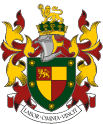KS4
Key Stage Four Curriculum Overview
GCSE Course Followed: Mathematics
- Specification: AQA (Syllabus 8300)
Content
- Number
- Algebra
- Ratio, proportion and rates of change
- Geometry and measures
- Probability and statistics
Examinations
All our students will be entered at the higher level. There are three examinations and these are all taken at the end of Year 11 with the exception of set 1 pupils who will take them in Year 10.
- Paper 1 (Non-Calculator) 1 hour 30 minutes, 33⅓% of the overall marks
- Paper 2 (Calculator) 1 hour 30 minutes, 33⅓% of the overall marks
- Paper 3 (Calculator) 1 hour 30 minutes, 33⅓% of the overall marks
- In each of these papers, content from any part of the specification may be assessed.
Year 1 GCSE
| Name of topic | Key Content of the Topic | Assessment points | |
|---|---|---|---|
|
HT1 |
Coordinates and linear graphs, sequences, percentages, rounding |
Calculating and using the equation of straight-line graphs, parallel and perpendicular lines. Linear, quadratic and geometric sequences, percentage revision, limits of accuracy. |
Termly assessment |
|
HT2 |
Representing data, 2D and 3D shapes, real life graphs |
Cumulative frequency diagrams, box plots and histograms. Properties of 2D shapes, area and perimeter, nets, plans and elevations. Interpreting real life graphs including speed-time and distance-time graphs |
|
|
HT3 |
Non-linear graphs, circles, ratio and proportion, linear equations, |
Calculating and interpreting the gradient of a curved graph, calculating and interpreting the area under a curved graph. Volume and surface area of prisms and cylinders, arc length and sector area. Ratio and proportion, solving linear equations. |
Termly assessment |
|
HT4 |
Introduction to quadratic expressions, basic probability, standard form, transformations and constructions |
Changing the subject, expanding and factorising quadratic expressions, substitution. Calculating probabilities, relative frequency, sample space diagrams, combinations of events and standard form. Reflection, rotation, translation, enlargement of 2D shapes, constructions and loci. |
|
|
HT5 |
Financial Maths, measures, averages and polygons |
Using percentages to solve financial problems, converting between units of measure, units of area and volume. Calculating and using averages, properties of polygons. |
|
|
HT6 |
Congruence, similarity, Pythagoras, trigonometry and complex probability |
Similar and congruent triangles and ratio in area and volume. Right angled trigonometry, Pythagoras’ theorem, tree diagrams, venn diagrams, conditional probability |

